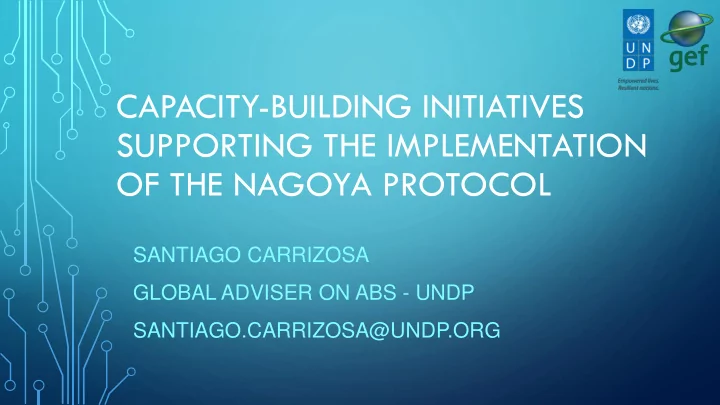

CAPACITY-BUILDING INITIATIVES SUPPORTING THE IMPLEMENTATION OF THE NAGOYA PROTOCOL SANTIAGO CARRIZOSA GLOBAL ADVISER ON ABS - UNDP SANTIAGO.CARRIZOSA@UNDP.ORG
AGENDA • Main challenges in terms of capacity development • Lessons for the design of future capacity-building initiatives. • Capturing, packing, and sharing lessons. • Capacity-building needs • Alignment between projects and the Capacity-Building Strategic Framework.
UNDP’S ABS PORTFOLIO: PROJECTS IN 43 COUNTRIES Belarus Mongolia Kazakhsta n Albania Tajikista China Lebanon n Jordan Morocco Bhutan Algeria Mexico Egypt Myanmar Dominican Rep. Vietnam Philippines Honduras Sudan India Cambodia Costa Rica Ethiopia Panama Cameroon Colombia Malaysia Kenya Rwanda Ecuador Seychelles Brazil Comoros Samoa Botswana Cook Islands Lesotho Fiji Uruguay South Africa Argentina
MAIN CHALLENGES IN TERMS OF CAPACITY BUILDING 1. Low visibility/relevance of ABS and low political profile for ABS matters. 2. Limited commitment from governments to provide long-term financing for the support of teams in government institutions focused on implementing and monitoring ABS. 3. Capacity-building efforts do not have the desired long-term impact as job stability is an issue in many government organizations.
LESSONS FOR THE DESIGN OF FUTURE CAPACITY-BUILDING INITIATIVES 1. Dialogue and coordination between current global, regional and local capacity-building initiatives is essential to ensure synergies, reduce costs and promote cooperation between countries. 2. ABS simulations where groups play the role of ABS government regulators and users/providers of genetic resources have proven to be a good capacity-building mechanism. 3. Mainstreaming gender into ABS is an effective strategy to ensure that women, men, youth, and elderly benefit from ABS deals. 4. More awareness on business models of industries that use genetic resources.
LESSONS FOR THE DESIGN OF FUTURE CAPACITY-DEVELOPMENT INITIATIVES 5. National policies for science/technology need to underscore the importance of using genetic resources for sustainable development.
CAPTURING, PACKING, AND SHARING LESSONS 1. Community of practice and south-south cooperation activities 2. Social media, blogs and articles 3. Capacity-building book on ABS 4. Book on contribution of ABS to SDGs
CAPACITY-BUILDING NEEDS 1. Traditional Knowledge and sui generis protection in the context of PIC and MAT 2. Platforms for national online permits and monitoring of ABS 3. Strategies to provide appropriate incentives for domestic and international private sector R&D
ALIGNMENT BETWEEN PROJECTS AND THE CAPACITY-BUILDING STRATEGIC FRAMEWORK • Key Area 1: Capacity to implement, and to comply with the obligations of, the Protocol 1. Albania 11.Colombia 21.India 31.Myanmar 2. Algeria 12.Comoros 22.Jordan 32.Panama 3. Argentina 13.Cook Islands 23.Kazakhstan 33.Philippines 4. Belarus 14.Costa Rica 24.Kenya 34.Rwanda 5. Bhutan 15.Dominican Rep. 25.Lebanon 35.Samoa 6. Botswana 16.Ecuador 26.Lesotho 36.Seychelles 7. Brazil 17.Egypt 27.Malaysia 37.South Africa 8. Cambodia 18.Ethiopia 28.Mexico 38.Sudan 9. Cameroon 19.Fiji 29.Mongolia 39.Tajikistan 10.China 20.Honduras 30.Morocco 40.Uruguay 41.Vietnam
• Key Area 2: Capacity to develop, implement and enforce domestic legislative, administrative or policy measures on access and benefit-sharing (ABS) 1. Albania 2. Algeria 3. Argentina 11.China 4. Belarus 12.Cook Islands 21.Kazakhstan 5. Bhutan 13.Costa Rica 22.Kenya 6. Botswana 14.Dominican Rep. 23.Lebanon 31.Philippines 7. Brazil 15.Ecuador 24.Lesotho 32.Rwanda 8. Cambodia 16.Egypt 25.Malaysia 33.Samoa 9. Cameroon 17.Ethiopia 26.Mexico 34.Seychelles 10.Comoros 18.Fiji 27.Mongolia 35.South Africa 19.Honduras 28.Morocco 36.Sudan 20.Jordan 29.Myanmar 37.Tajikistan 30.Panama 38.Uruguay 39.Vietnam
• Key Area 3: Capacity to negotiate mutually-agreed terms (MAT) 1. Albania 12.Comoros 23.Kenya 34.Samoa 2. Algeria 13.Costa Rica 24.Lebanon 35.Seychelles 3. Argentina 14.Dominican Rep. 25.Lesotho 36.South Africa 4. Belarus 15.Ecuador 26.Malaysia 37.Sudan 5. Bhutan 16.Egypt 27.Mexico 38.Tajikistan 6. Botswana 17.Ethiopia 28.Mongolia 39.Uruguay 7. Brazil 18.Fiji 29.Morocco 40.Vietnam 8. Cameroon 19.Honduras 30.Myanmar 9. China 20.India 31.Panama 10.Cook Islands 21.Jordan 32.Philippines 11.Colombia 22.Kazakhstan 33.Rwanda
• Key Area 4: Capacity needs and priorities of indigenous and local communities (ILCs) and relevant stakeholders, including the business sector and the research community 1. Albania 11.Cook Islands 21.Lebanon 31.Seychelles 2. Algeria 12.Dominican Rep. 22.Lesotho 32.South Africa 3. Argentina 13.Egypt 23.Malaysia 33.Tajikistan 4. Belarus 14.Ethiopia 24.Mexico 34.Uruguay 5. Botswana 15.Fiji 25.Mongolia 35.Vietnam 6. Brazil 16.Honduras 26.Morocco 7. Cameroon 17.India 27.Myanmar 8. China 18.Jordan 28.Panama 9. Colombia 19.Kazakhstan 29.Rwanda 10.Comoros 20.Kenya 30.Samoa
• Key Area 5: Capacity of countries to develop their endogenous research capabilities to add value to their own genetic resources (GR) 1. Argentina 10.Dominican Rep. 19.South Africa 2. Belarus 11.Ecuador 20.Uruguay 3. Botswana 12.Ethiopia 21.Vietnam 4. Brazil 13.Fiji 5. Cameroon 14.India 6. China 15.Lesotho 7. Colombia 16.Malaysia 8. Cook Islands 17.Panama 9. Costa Rica 18.Seychelles
THANK YOU!
Recommend
More recommend